
- Subject:
- Biology
- Material Type:
- Unit of Study
- Provider:
- Rice University
- Provider Set:
- OpenStax College



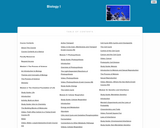
An introduction to biology intended for non-science majors. Focus areas include chemical foundations, cell structure and division, genetics, and evolution.
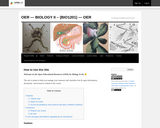
This site is an OER for BIology II and contains all the materials needed for the course including lecture slides and labs.
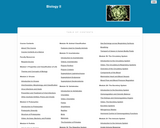
This template course was developed from generally available open educational resources (OER) in use at multiple institutions, drawing mostly from a primary work published by OpenStax College Concepts of Biology, but also including additional open works from various sources as noted in attributions on each page of materials.

This course outline for Biology II includes resources for both students and instructors including the OpenStax Biology textbook, lecture schedule, lecture slides, labs, list of related resources and Interdisciplinary (ID) Biology II topics and assignments.


Students perform a literature review on a biology topic, choose 2-3 papers published in scientific journals to discuss in their assignment, provide a final opinion on the topic, and some voluntarily present on their selected topic.

"This course covers the principles of materials science and cell biology underlying the design of medical implants, artificial organs, and matrices for tissue engineering. Methods for biomaterials surface characterization and analysis of protein adsorption on biomaterials. Molecular and cellular interactions with biomaterials are analyzed in terms of unit cell processes, such as matrix synthesis, degradation, and contraction. Mechanisms underlying wound healing and tissue remodeling following implantation in various organs. Tissue and organ regeneration. Design of implants and prostheses based on control of biomaterials-tissue interactions. Comparative analysis of intact, biodegradable, and bioreplaceable implants by reference to case studies. Criteria for restoration of physiological function for tissues and organs."

A seminar-based course that exposes students to current research topics in the fields of Bioinformatics and Medical Informatics. Weekly presentations by invited speakers and/or faculty introduce students to the broad diversity of research areas in both fields, and engages them in critical thinking and writing. Online lectures and reading activities will be given periodically.
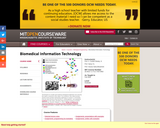
" This course teaches the design of contemporary information systems for biological and medical data. Examples are chosen from biology and medicine to illustrate complete life cycle information systems, beginning with data acquisition, following to data storage and finally to retrieval and analysis. Design of appropriate databases, client-server strategies, data interchange protocols, and computational modeling architectures. Students are expected to have some familiarity with scientific application software and a basic understanding of at least one contemporary programming language (e.g. C, C++, Java, Lisp, Perl, Python). A major term project is required of all students. This subject is open to motivated seniors having a strong interest in biomedical engineering and information system design with the ability to carry out a significant independent project. This course was offered as part of the Singapore-MIT Alliance (SMA) program as course number SMA 5304."

This subject deals primarily with kinetic and equilibrium mathematical models of biomolecular interactions, as well as the application of these quantitative analyses to biological problems across a wide range of levels of organization, from individual molecular interactions to populations of cells.

This course will explore three modules of learning.
Anatomy and Psycho-Physical Centering, will explore two foundations: (1) the start of our research and practical application of the human anatomy in regards to how our body moves; and (2) your ability to tune into movement centers within the body by utilizing Chakra as a guiding study. Please note: Anatomy will be a continuous study throughout the entire semester.
THE SECOND MODULE, Partnered Connection, will focus on partnering with lifts, counter-balances, falls, and rolls that will build to a partnering sequence of the tools presented.
THE LAST MODULE, Global Archetypes, will explore archetypal dynamics in movement and how that connects to others, physical impulses, and given circumstances. This coursework aims to refine and expand proficiency in physical skills and the ability to embody and perform in an authentic, expressive, and unedited manner.
● Application of the learned movement techniques will be assessed in various homework exercises, daily ensemble participation, quizzes, and three in-class performances.

The full OpenStax Biology course, together with digital exercises that are repeated in an efficient way to help you achieve lifelong mastery in the subject material.
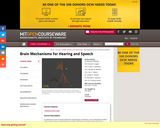
An advanced course covering anatomical, physiological, behavioral, and computational studies of the central nervous system relevant to speech and hearing. Students learn primarily by discussions of scientific papers on topics of current interest. Recent topics include cell types and neural circuits in the auditory brainstem, organization and processing in the auditory cortex, auditory reflexes and descending systems, functional imaging of the human auditory system, quantitative methods for relating neural responses to behavior, speech motor control, cortical representation of language, and auditory learning in songbirds.
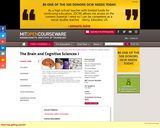
Survey of principles underlying the structure and function of the nervous system, integrating molecular, cellular, and systems approaches. Topics: development of the nervous system and its connections, cell biology or neurons, neurotransmitters and synaptic transmission, sensory systems of the brain, the neuroendocrine system, the motor system, higher cortical functions, behavioral and cellular analyses of learning and memory. First half of an intensive two-term survey of brain and behavioral studies for first-year graduate students. Open to graduate students in other departments, with permission of instructor.

This course has been designed as a seminar to give students an understanding of how scientists with medical or scientific degrees conduct research in both hospital and academic settings. There will be interactive discussions with research clinicians and scientists about the career opportunities and research challenges in the biomedical field, which an MIT student might prepare for by obtaining an MD, PhD, or combined degrees. The seminar will be held in a case presentation format, with topics chosen from the radiological sciences, including current research in magnetic resonance imaging, positron emission tomography and other nuclear imaging techniques, and advances in radiation therapy. With the lectures as background, we will also examine alternative and related options such as biomedical engineering, medical physics, and medical engineering. We'll use as examples and points of comparisons the curriculum paths available through MIT's Department of Nuclear Science and Engineering. In past years we have given very modest assignments such as readings in advance of or after a seminar, and a short term project.
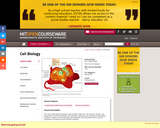
Biology of cells of higher organisms: structure, function, and biosynthesis of cellular membranes and organelles; cell growth and oncogenic transformation; transport, receptors and cell signaling; the cytoskeleton, the extracellular matrix, and cell movements; chromatin structure and RNA synthesis.
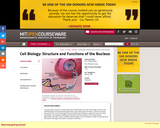
The goal of this course is to teach both the fundamentals of nuclear cell biology as well as the methodological and experimental approaches upon which they are based. Lectures and class discussions will cover the background and fundamental findings in a particular area of nuclear cell biology. The assigned readings will provide concrete examples of the experimental approaches and logic used to establish these findings. Some examples of topics include genome and systems biology, transcription, and gene expression.